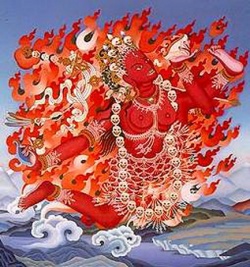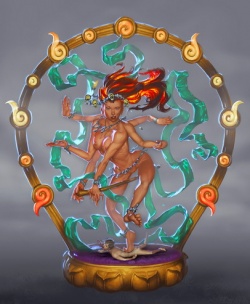Consort
1. A husband or wife, especially the spouse of a monarch.
2. A companion or partner.
3. A ship accompanying another in travel.
4. Partnership; association: governed in consort with her advisers.
1. (intr; usually foll by with) to keep company (with undesirable people); associate
2. (intr) to agree or harmonize
3. (tr) Rare to combine or unite
In Buddhism traditionally, the term dakini has been used for outstanding female practitioners, consorts of great masters, and to denote the enlightened female principle of non-duality which transcends gender.
The outer-outer dakini is a dakini in human form. She is a yogini, or Tantric practitioner in her own right but may also be a kamamudra, or consort, of a yogi or mahasiddha. The Nirmanakaya dakinis are human women born with special potentialities; these are realized yogini, the consorts.
When the completion stage practices have been mastered and we have gained control over our subtle energy winds and so forth, there will come a time when the dakas and dakinis will come... physically embracing such a consort is necessary to bring all the pervading energy winds into the central channel, a prerequisite for opening the heart center and experiencing the profoundest level of clear light.
Here is some disagreement amongst Western scholars as to the meaning of the term daka. Some see it as the same as a dakini but in its male embodiment, and thus to be the partner of a female practitioner or yogini, or to identify a daka as the consort of a dakini. However in consort yoga, the consort of a dakini is a yogi. For example, the most famous instance of consort yoga in Tibetan tantra involved its founder, the Indian Mahasiddha Padmasambhava and Yeshe Tsogyal, a Tibetan princess and yogini. Padma Sambhava was known as a yogi and Yeshe Tsogyal as a dakini.
The Vajrayana or tantric tradition says that spirituality in the fullest sense cannot be an isolated, solitary, purely self-involved enterprise. Rather, we make the deepest journey of transformation and ultimate fulfillment only in relationship—with our deepest nature, with our unique karmic situations, with the people in our lives, and with the living universe around us. Through being in connection with these others, we are inspired, we love, and we open. We learn at the deepest levels that we are never one alone but always two-by-two, always in connection, always in the love relationship with all that is; and therein lies our life and our realization.
The tantric consort is the ultimate other. In fact, in the tantric tradition, it is said that moment by moment, he or she represents to us the entire phenomenal world. In other words, in the consort, we most deeply and completely meet the sacred universe in its entirety—a perhaps outrageous claim, but one that experience proves. Through the practice of taking the consort as representing the sacred totality, we learn to love more deeply than we ever imagined possible—first the consort, then everything that is. We see where we habitually hold back and hide out; we practice ways to release our masks, blockages, and obstacles; and ultimately we find union, where releasing our narcissistic fixation on ourselves and discovering our profound and eternal oneness with the consort—and through him or her the world—are the same thing. Ultimately, our ability to journey on the path of the tantric consort comes down to our own willingness, bravery, and devotion in cultivating an open heart and in learning to love the beloved openly and without limit.

